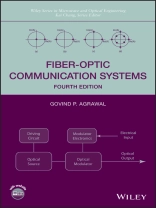This book provides a comprehensive account of fiber-optic
communication systems. The 3rd edition of this book is
used worldwide as a textbook in many universities. This 4th
edition incorporates recent advances that have occurred, in
particular two new chapters. One deals with the advanced modulation
formats (such as DPSK, QPSK, and QAM) that are increasingly being
used for improving spectral efficiency of WDM lightwave systems.
The second chapter focuses on new techniques such as
all-optical regeneration that are under development and likely to
be used in future communication systems. All other
chapters are updated, as well.
Tabella dei contenuti
Preface xv
1 Introduction 1
1.1 Historical Perspective 1
1.2 Basic Concepts 8
1.3 Optical Communication Systems 16
1.4 Lightwave System Components 17
Problems 20
References 21
2 Optical Fibers 24
2.1 Geometrical-Optics Description 24
2.2 Wave Propagation 29
2.3 Dispersion in Single-Mode Fibers 38
2.4 Dispersion-Induced Limitations 46
2.5 Fiber Losses 55
2.6 Nonlinear Optical Effects 59
2.7 Fiber Design and Fabrication 67
Problems 74
References 75
3 Optical Transmitters 79
3.1 Semiconductor Laser Physics 79
3.2 Single-Mode Semiconductor Lasers 87
3.3 Laser Characteristics 94
3.4 Optical Signal Generation 104
3.5 Light-Emitting Diodes 110
3.6 Transmitter Design 115
Problems 121
References 122
4 Optical Receivers 128
4.1 Basic Concepts 128
4.2 Common Photodetectors 131
4.3 Receiver Design 144
4.4 Receiver Noise 148
4.5 Coherent Detection 158
4.6 Receiver Sensitivity 161
4.7 Sensitivity Degradation 167
4.8 Receiver Performance 173
Problems 175
References 177
5 Lightwave Systems 182
5.1 System Architectures 182
5.2 Design Guidelines 187
5.3 Long-Haul Systems 194
5.4 Sources of Power Penalty 200
5.5 Forward Error Correction 212
5.6 Computer-Aided Design 214
Problems 216
References 218
6 Multichannel Systems 223
6.1 WDM Lightwave Systems 223
6.2 WDM Components 232
6.3 System Performance Issues 251
6.4 Time-Division Multiplexing 264
6.5 Subcarrier Multiplexing 269
6.6 Code-Division Multiplexing 277
Problems 283
References 285
7 Loss Management 295
7.1 Compensation of Fiber Losses 295
7.2 Erbium-Doped Fiber Amplifiers 300
7.3 Raman Amplifiers 310
7.4 Optical Signal-To-Noise Ratio 318
7.5 Electrical Signal-To-Noise Ratio 321
7.6 Receiver Sensitivity and Q Factor 325
7.7 Role of Dispersive and Nonlinear Effects 328
7.8 Periodically Amplified Lightwave Systems 334
Problems 339
References 340
8 Dispersion Management 345
8.1 Dispersion Problem and Its Solution 345
8.2 Dispersion-Compensating Fibers 347
8.3 Fiber Bragg Gratings 354
8.4 Dispersion-Equalizing Filters 363
8.5 Optical Phase Conjugation 369
8.6 Channels at High Bit Rates 375
8.7 Electronic Dispersion Compensation 385
Problems 397
References 399
9 Control of Nonlinear Effects 407
9.1 Impact of Fiber Nonlinearity 407
9.2 Solitons in Optical Fibers 416
9.3 Dispersion-Managed Solitons 423
9.4 Pseudo-linear Lightwave Systems 434
9.5 Control of Intrachannel Nonlinear Effects 444
Problems 451
References 453
10 Advanced Lightwave Systems 459
10.1 Advanced Modulation Formats 460
10.2 Demodulation Schemes 464
10.3 Shot Noise and Bit-Error Rate 470
10.4 Sensitivity Degradation Mechanisms 476
10.5 Impact of Nonlinear Effects 485
10.6 Recent Progress 494
10.7 Ultimate Channel Capacity 501
Problems 503
References 504
11 Optical Signal Processing 511
11.1 Nonlinear Techniques and Devices 511
11.2 All-Optical Flip-Flops 529
11.3 Wavelength Converters 533
11.4 Ultrafast Optical Switching 544
11.5 Optical Regenerators 553
Problems 568
References 569
A System of Units 578
B Acronyms 580
C General Formula for Pulse Broadening 584
D Software Package 587
Index 589
Circa l’autore
GOVIND P. AGRAWAL is a professor at the Institute of Optics at the University of Rochester and a Fellow of both the Optical Society of America and the Institute of Electrical and Electronics Engineering. He is also a Senior Scientist at the Laboratory for Laser Energetics. Dr. Agrawal is author or coauthor of more than 300 research papers, book chapters, and monographs.












